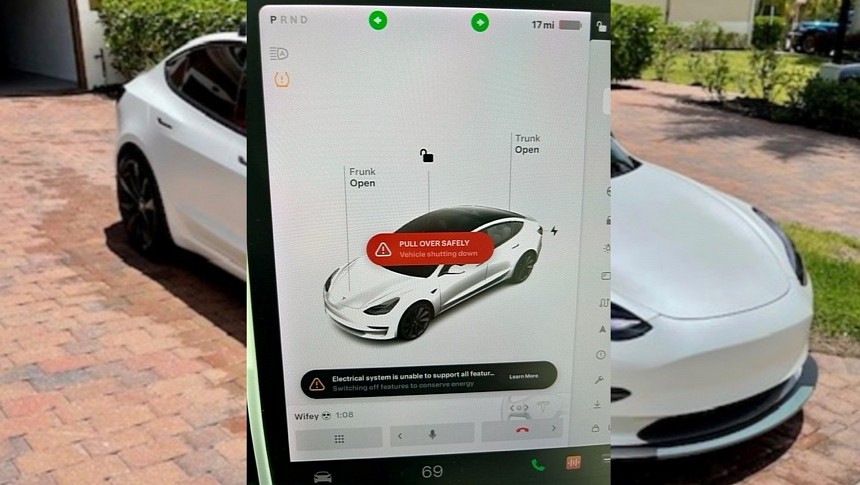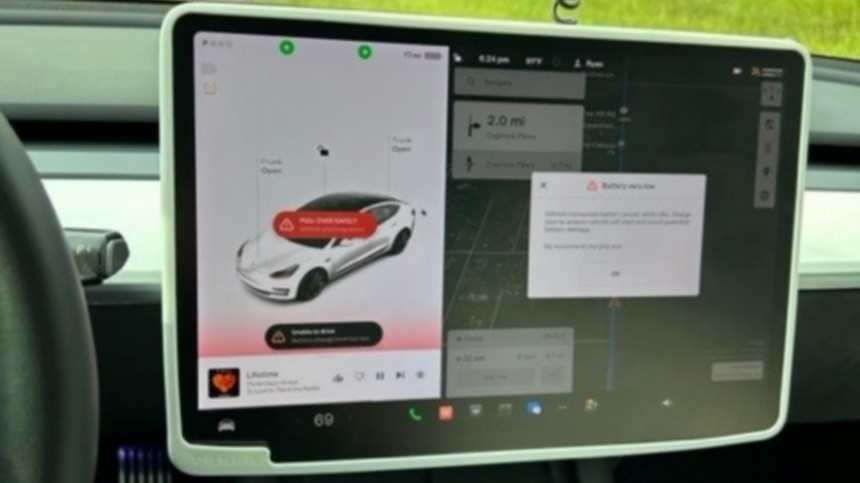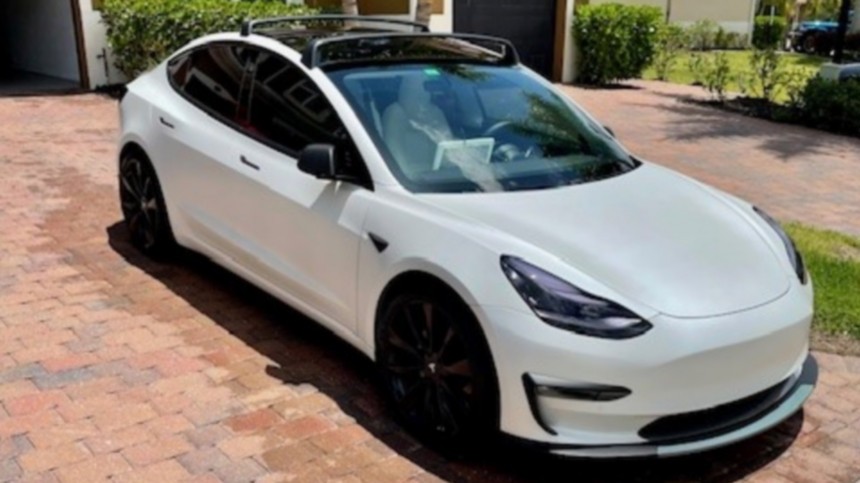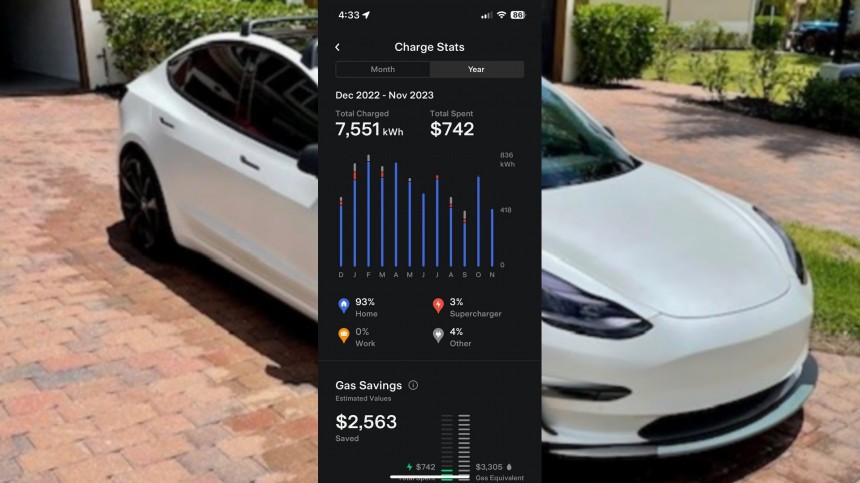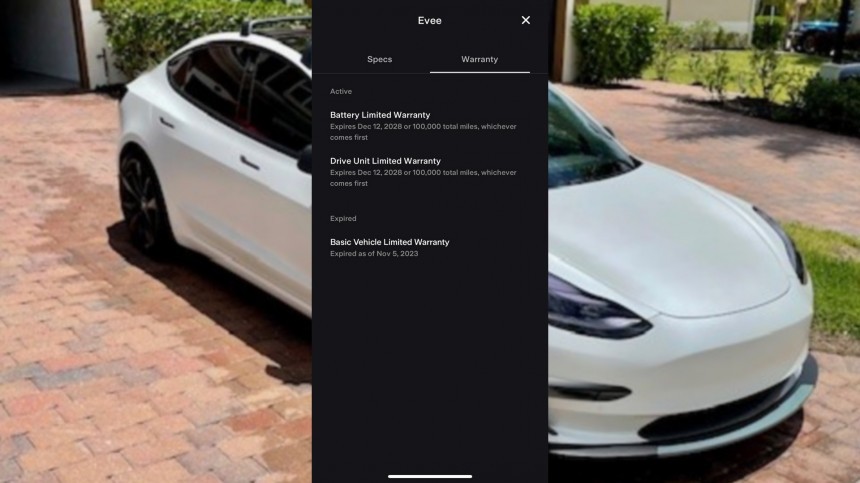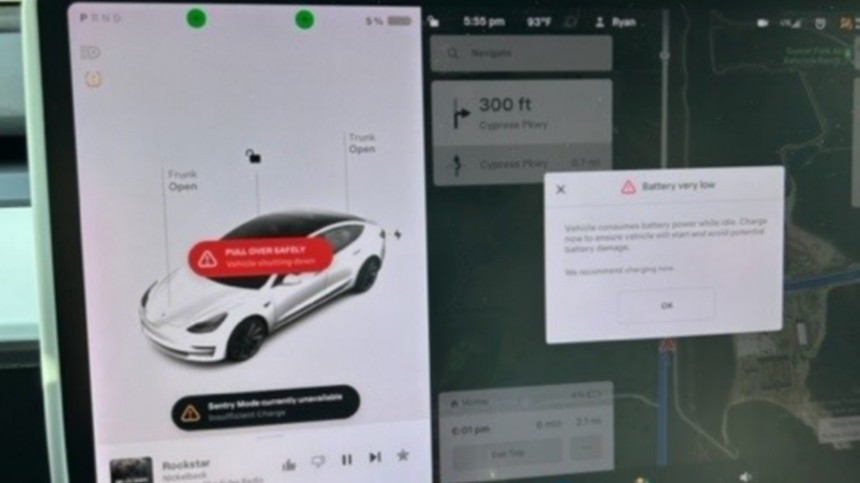Ryan Thomas was a Tesla supporter long before he purchased his used 2021 Model 3 RWD with 15,000 miles on March 29, 2022. He said his battery electric vehicle (BEV) has a promised EPA range of 272 miles, which it never achieved. The good thing was that it was more than enough for Thomas to travel from Babcock Ranch to his work in Sarasota, Florida, and back. He told autoevolution his 110-mile daily commute was covered with no issues until August 15, 2023. That was the first time the BEV left Thomas stranded – and it would happen again.
For the Model 3 owner, that triggered a nightmare. Before we get there, it is essential to describe the steps leading to this first scary situation. As Thomas said, he never managed to drive his BEV for 272 miles on a full charge or even "anywhere close to that range." In part, that's because the Model 3 owner always strictly followed Tesla's charging recommendations.
"I used to charge my car only to 90% capacity (which was the capacity that Tesla recommended) until August 2023. As for supercharging, I rarely ever do it. I mostly just plug in at home, but I have used the supercharger on occasion."
Thomas had driven his car for 35,000 more miles with no issues until he noticed a severe range drop with the car, which led him to increase the charging limit to 95% so that he could get to work and back on a single charge, as he used to do before that. On August 15, something weird happened.
"I was driving home from work on a two-lane highway when my car suddenly (and without any warning) lost all driving power and shut down while there was still battery left on the vehicle (roughly 10%). I could no longer maneuver the vehicle due to a complete lack of propulsion, so my car died in the middle of the road and left me stranded."
Thomas had his vehicle towed to the Fort Myers Tesla Service Center, where the technicians told him that the car "died simply due to insufficient charge (even though there was still about 10% battery left at the time of the incident)."
"When I showed them the pictures of what really happened to dispute this claim, the service advisor dismissed my concern and said to just keep the battery percentage above 10%."
Whenever any BEV is running out of charge, it will tell the driver to stop. In several tests with Tesla vehicles, including one with Carwow, the driver was told to get to a charger soon. It even said "all known charging locations" would quickly be out of range when the vehicle had only 5% range left. When the charge dropped below 0%, the car would still run for a bit. An Edmunds story reinforces that "Tesla's vehicles give you plenty of warning as the end draws nigh, with multiple notifications popping up to tell you that the battery is getting low and needs to be recharged soon." Tesla's vehicles may do that, but Thomas' BEV didn't. He did not receive any such warnings when his vehicle stopped for a second time, now theoretically with a 7% charge left, as the pictures show.
"About a week later (August 21), the same thing happened! Again, my car lost all power and completely shut down mid-drive without any warning. Again, I was left stranded in the middle of the road, and the car had to be towed to the service center. Both times, I had my home address in the car's GPS (so the computer knew the exact distance I was traveling), and it never indicated once that I needed to stop and charge the battery."
Despite behaving in a way his car shouldn't, Thomas has received a standard reply from Tesla: his car was "within specs." For the company, he was to blame because he did not keep his BEV above 10% charge. He even tried taking his Model 3 to a different service center – in Sarasota.
"There, the service techs were more helpful and even offered to take the car on an extended drive to their home for the night (27 miles away). The funny thing was that the technician left the service center with a 35% charge, then turned back around and proceeded back to the service center to supercharge the car to 76% (presumably because the tech realized that they would not reach their destination based on the way the car was driving and did not want to be stranded in the road). To my amazement, the shop supervisor called me the next day and told me that there was nothing wrong with my vehicle."
That answer obviously did not bring any relief to Thomas, who insisted on having a better explanation from the supervisor.
"He said that they ran more diagnostics and found that the battery was degraded, but just not to the point that Tesla will warranty a battery replacement. I asked for the battery degradation report to see the current status of my battery but was told it was "proprietary company property" and that I was not entitled to the report (even though I own the car?). Additionally, they were unwilling to take the car for a test drive under 10% battery to replicate the issue I'm having (which is the same parameter when my car died twice). The supervisor said that, even if he did experience that issue, Tesla would still not let him warranty the battery because the diagnostic tests did not indicate any issues. So, they told me I must pick up my car because it is 'drivable' or face incurring daily fees for the loaner vehicle."
It was even a bit worse than that.
"They tried attributing part of the battery issue to supercharging. However, I probably have supercharged my car less than ten times total since I've owned the Tesla. Looking at my charge stats in the app, it says that I have used the supercharger only 3% over the past year (from December 2022 to November 2023). So, I don't think supercharging is the culprit behind my issue."
Supposing Tesla presented an accurate mileage for each complete charge its vehicles display, the battery pack on Thomas' Model 3 would have had to be replaced long ago. If the EPA range is 272 miles, 150 miles would represent 55.1% of the original capacity. Tesla's warranty terms say the BEV maker will replace the battery pack within eight years or 100,000 miles if it fails or drops below 70% capacity. Thomas' Model 3 mileage states this minimum is much lower than it should be in that vehicle. The least the Sarasota Service Center should have done was to tell him how much capacity his car originally had and how much it currently presents.
If the Tesla Service Center is being honest about the battery pack condition, why doesn't it explain why a 55.1% drop in capacity is not eligible for a battery pack replacement? If there is any way to justify that, it may have to do with another issue Tesla put itself into: the accusations regarding the range presented by its vehicles. On July 27, Reuters revealed that the BEV maker rigged its range estimates always to show the best number the car could achieve at all times – even those in which they would never reach such distances, such as cold weather.
According to Reuters, that was something Elon Musk ordered his engineers to do. What the range calculator did was to make the number drop to more realistic figures after the battery pack went below 50% charge. The driver would have "about 15 miles (24 km) of additional range even after the dash readout showed an empty battery" because Tesla designed a safety buffer that would prevent them from running out of juice in dangerous situations. Again, when the car apparently had zero charge left – as the computer displayed – it could still drive around 15 miles. In Thomas' case, it was right the opposite: although his BEV said he still had some charge left, it stopped without any warnings. It would be like an internal combustion engine (ICE) car dying without hitting the fuel reserve. Any mechanic would tell you the vehicle had a problem. Yet, Tesla says Thomas' Model 3 is working as it should despite a mild battery pack degradation. Stopping without warnings does not look normal, and Thomas rightfully wants to understand why that is happening.
"Basically, I've exhausted all available avenues of support with Tesla regarding my defective vehicle. I've contacted customer support, spoken with lead technicians, emailed the legal department, and even pleaded my case to the service center supervisors. No one at Tesla seems to care or even wants to help fix my car. They keep telling me that nothing is wrong with it, even though I have documented proof that my car is dying without any warning at a battery level greater than zero percent. So, something is wrong with my vehicle's main battery or with the battery percentage meter being displayed. Either way, Tesla should try to replicate the issue and fix the source of the defect. Unfortunately, Tesla does not want to do either of those options and, instead, tells me that nothing is wrong with the vehicle."
Thomas wanted to share his story to tell other Tesla owners facing the same situation that they are not alone. The Model 3 owner said he found "numerous similar safety complaints filed through the NHTSA" for the same model year of his vehicle.
"Having the car randomly shut off while driving is a huge safety concern. What am I supposed to do if my car decides to just shut off while I'm on the interstate with my two young daughters strapped into their car seats? There would be no way to safely remove them from the vehicle (let alone myself) before being involved in a serious high-speed accident. I might have time to escape the car, but what about them? Who is going to advocate for their safety if I don't?"
When he made these questions to a Tesla supervisor, he heard that he should not let his vehicle "get below 10% charge."
"Sure, if the car were functioning correctly, I would be able to make my 110-mile round trip commute without having to dip below 10% battery level. However, that is simply not the reality that I am facing with my vehicle. I considered selling my car, but I could not live with myself, pawning off this safety issue onto an unsuspecting purchaser. Trading in the vehicle is also not an option as I would be underwater with my car loan due to purchasing it at the height of the market and Tesla essentially devaluing all models with their recent price reductions. It really pains me to say, but I wish I never purchased my Tesla."
"I used to charge my car only to 90% capacity (which was the capacity that Tesla recommended) until August 2023. As for supercharging, I rarely ever do it. I mostly just plug in at home, but I have used the supercharger on occasion."
Thomas had driven his car for 35,000 more miles with no issues until he noticed a severe range drop with the car, which led him to increase the charging limit to 95% so that he could get to work and back on a single charge, as he used to do before that. On August 15, something weird happened.
"I was driving home from work on a two-lane highway when my car suddenly (and without any warning) lost all driving power and shut down while there was still battery left on the vehicle (roughly 10%). I could no longer maneuver the vehicle due to a complete lack of propulsion, so my car died in the middle of the road and left me stranded."
"When I showed them the pictures of what really happened to dispute this claim, the service advisor dismissed my concern and said to just keep the battery percentage above 10%."
Whenever any BEV is running out of charge, it will tell the driver to stop. In several tests with Tesla vehicles, including one with Carwow, the driver was told to get to a charger soon. It even said "all known charging locations" would quickly be out of range when the vehicle had only 5% range left. When the charge dropped below 0%, the car would still run for a bit. An Edmunds story reinforces that "Tesla's vehicles give you plenty of warning as the end draws nigh, with multiple notifications popping up to tell you that the battery is getting low and needs to be recharged soon." Tesla's vehicles may do that, but Thomas' BEV didn't. He did not receive any such warnings when his vehicle stopped for a second time, now theoretically with a 7% charge left, as the pictures show.
"About a week later (August 21), the same thing happened! Again, my car lost all power and completely shut down mid-drive without any warning. Again, I was left stranded in the middle of the road, and the car had to be towed to the service center. Both times, I had my home address in the car's GPS (so the computer knew the exact distance I was traveling), and it never indicated once that I needed to stop and charge the battery."
"There, the service techs were more helpful and even offered to take the car on an extended drive to their home for the night (27 miles away). The funny thing was that the technician left the service center with a 35% charge, then turned back around and proceeded back to the service center to supercharge the car to 76% (presumably because the tech realized that they would not reach their destination based on the way the car was driving and did not want to be stranded in the road). To my amazement, the shop supervisor called me the next day and told me that there was nothing wrong with my vehicle."
That answer obviously did not bring any relief to Thomas, who insisted on having a better explanation from the supervisor.
"He said that they ran more diagnostics and found that the battery was degraded, but just not to the point that Tesla will warranty a battery replacement. I asked for the battery degradation report to see the current status of my battery but was told it was "proprietary company property" and that I was not entitled to the report (even though I own the car?). Additionally, they were unwilling to take the car for a test drive under 10% battery to replicate the issue I'm having (which is the same parameter when my car died twice). The supervisor said that, even if he did experience that issue, Tesla would still not let him warranty the battery because the diagnostic tests did not indicate any issues. So, they told me I must pick up my car because it is 'drivable' or face incurring daily fees for the loaner vehicle."
"They tried attributing part of the battery issue to supercharging. However, I probably have supercharged my car less than ten times total since I've owned the Tesla. Looking at my charge stats in the app, it says that I have used the supercharger only 3% over the past year (from December 2022 to November 2023). So, I don't think supercharging is the culprit behind my issue."
Supposing Tesla presented an accurate mileage for each complete charge its vehicles display, the battery pack on Thomas' Model 3 would have had to be replaced long ago. If the EPA range is 272 miles, 150 miles would represent 55.1% of the original capacity. Tesla's warranty terms say the BEV maker will replace the battery pack within eight years or 100,000 miles if it fails or drops below 70% capacity. Thomas' Model 3 mileage states this minimum is much lower than it should be in that vehicle. The least the Sarasota Service Center should have done was to tell him how much capacity his car originally had and how much it currently presents.
According to Reuters, that was something Elon Musk ordered his engineers to do. What the range calculator did was to make the number drop to more realistic figures after the battery pack went below 50% charge. The driver would have "about 15 miles (24 km) of additional range even after the dash readout showed an empty battery" because Tesla designed a safety buffer that would prevent them from running out of juice in dangerous situations. Again, when the car apparently had zero charge left – as the computer displayed – it could still drive around 15 miles. In Thomas' case, it was right the opposite: although his BEV said he still had some charge left, it stopped without any warnings. It would be like an internal combustion engine (ICE) car dying without hitting the fuel reserve. Any mechanic would tell you the vehicle had a problem. Yet, Tesla says Thomas' Model 3 is working as it should despite a mild battery pack degradation. Stopping without warnings does not look normal, and Thomas rightfully wants to understand why that is happening.
"Basically, I've exhausted all available avenues of support with Tesla regarding my defective vehicle. I've contacted customer support, spoken with lead technicians, emailed the legal department, and even pleaded my case to the service center supervisors. No one at Tesla seems to care or even wants to help fix my car. They keep telling me that nothing is wrong with it, even though I have documented proof that my car is dying without any warning at a battery level greater than zero percent. So, something is wrong with my vehicle's main battery or with the battery percentage meter being displayed. Either way, Tesla should try to replicate the issue and fix the source of the defect. Unfortunately, Tesla does not want to do either of those options and, instead, tells me that nothing is wrong with the vehicle."
"Having the car randomly shut off while driving is a huge safety concern. What am I supposed to do if my car decides to just shut off while I'm on the interstate with my two young daughters strapped into their car seats? There would be no way to safely remove them from the vehicle (let alone myself) before being involved in a serious high-speed accident. I might have time to escape the car, but what about them? Who is going to advocate for their safety if I don't?"
When he made these questions to a Tesla supervisor, he heard that he should not let his vehicle "get below 10% charge."
"Sure, if the car were functioning correctly, I would be able to make my 110-mile round trip commute without having to dip below 10% battery level. However, that is simply not the reality that I am facing with my vehicle. I considered selling my car, but I could not live with myself, pawning off this safety issue onto an unsuspecting purchaser. Trading in the vehicle is also not an option as I would be underwater with my car loan due to purchasing it at the height of the market and Tesla essentially devaluing all models with their recent price reductions. It really pains me to say, but I wish I never purchased my Tesla."
